By structure grammatical basis sentences are divided Two-part One-part Complete grammatical basis - subject and predicate It is not without reason that the proverb says it. One main member sentences - either subject or predicate Denominative: Evening. Definitely personal: Words cannot help my grief. Vaguely personal: They judge not by words, but by deeds. Impersonal: It's getting light.
One-part sentences Definitely personal Indefinitely personal Impersonal Nominatives A certain person acts (1st, 2nd person; imperative) Acts unidentified person(plural, 3rd person, present and future tense or plural past tense) The state of a person or nature is called. Names the presence of an object, phenomenon.
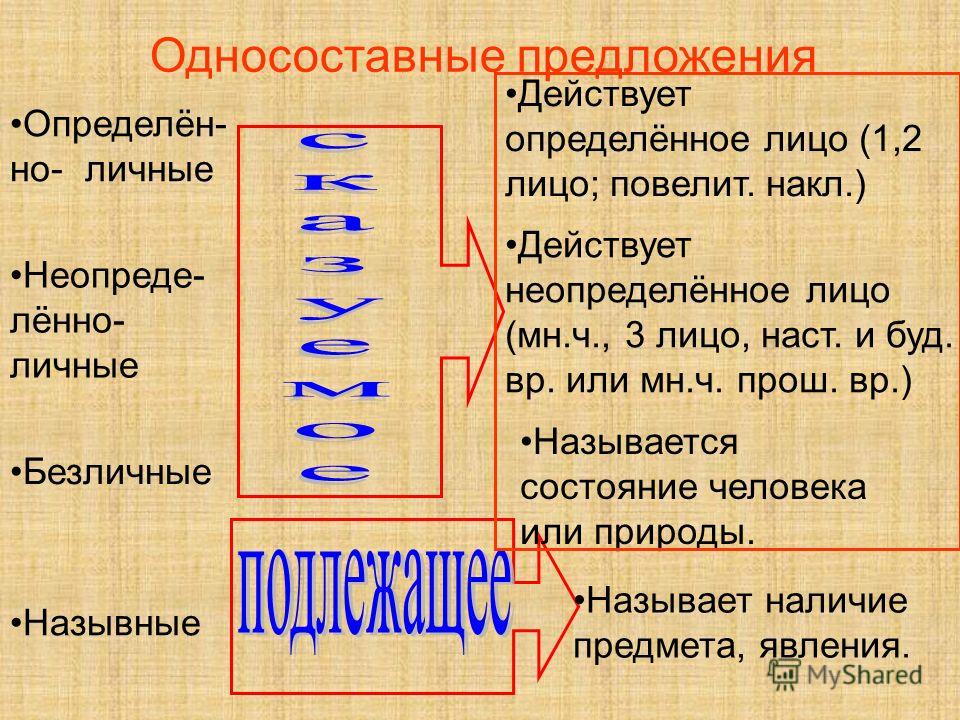
Determine the type of one-part sentences. 1. It begins to get dark. 2.Sunset. 3.The streets in the city are cleaned in the morning. 4. Without constant work you will not gain knowledge. 5. In winter you dream of the sun. 6.I'm not feeling well. 7. They meet you by their clothes, they see them off by their intelligence. 8. Bread is the head of everything.
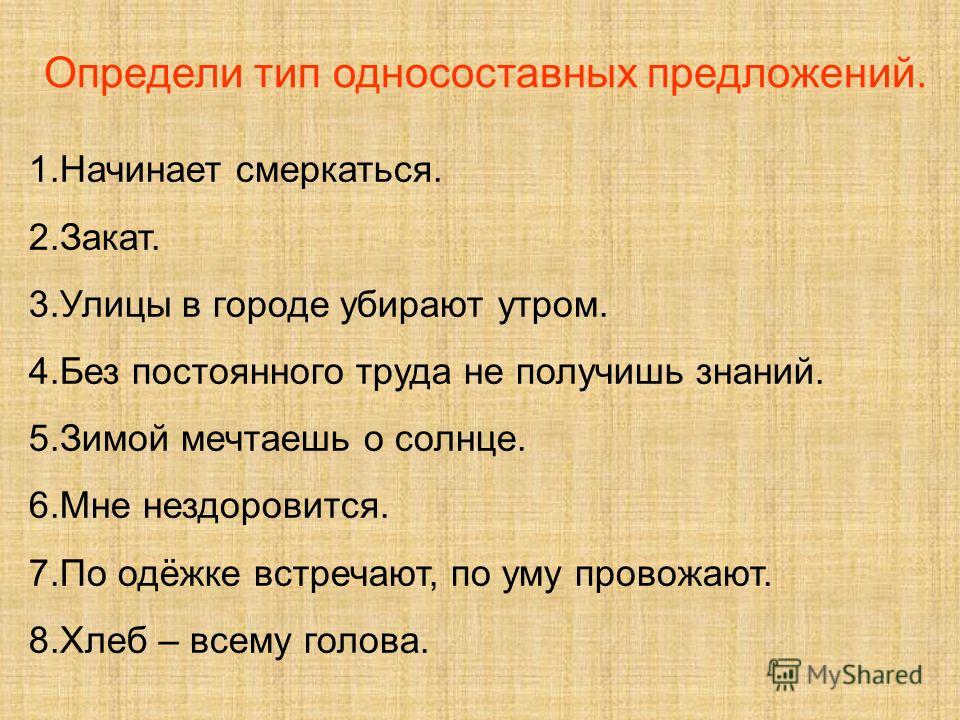
1. It begins to get dark. (one-part, impersonal: talking about the state of nature.) 2. Sunset. (one-part, nominative,: it says about the presence of sunset, there is no predicate). 3. The streets in the city are cleaned in the morning. (single-part, undefined-personal, verb in the form of 3rd person plural, present tense - “they” are removed). 4. You won’t get it without constant work. good knowledge. (single-part, definite - personal, the verb is used in the form of the 2nd person, singular, present tense - “you” will not receive).
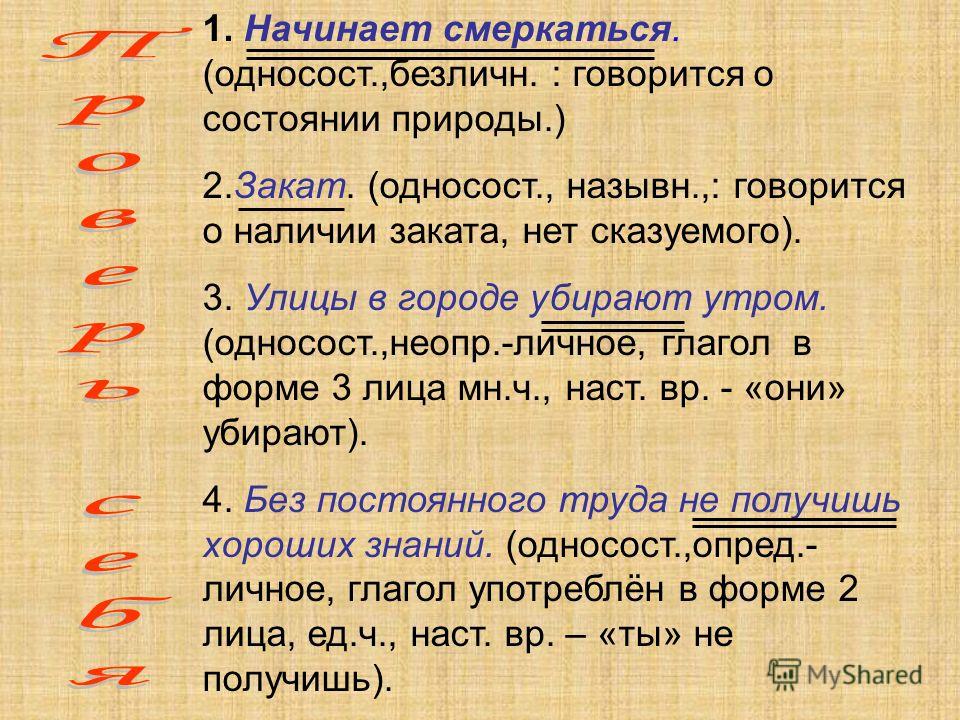
5. In winter you dream of the sun. (single-part, definite-personal, “you” are dreaming - the verb is used in the 2nd person form, singular, present tense). 6. I'm not feeling well. (one-part, impersonal - it speaks about the human condition). 7. They meet you by their clothes, they see them off by their intelligence. (single-part, indefinite – “they” meet, the verb is used in the third person form, plural, present time) 8. Bread is the head of everything. (two-part)
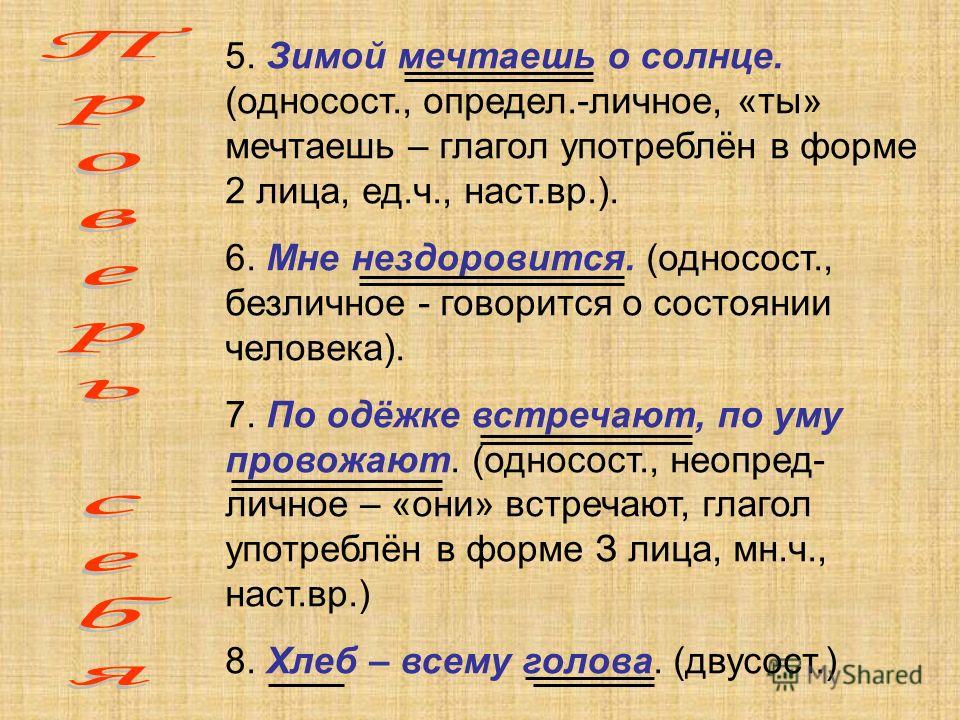
Why did the poet refuse to use the pronoun “I” in definitely personal sentences? I’m returning to the land of my fathers!.. I love the damp smells of bad weather And the wet noise of excited forests. I love to wander alone in the damp lowlands..., I love to...deal with...themselves in the...country... (I. Shklyarovsky). Underline the predicates, what form of the verb are they expressed? a a a nn o o e i (1 sheet, unit, present time)

Definitely personal sentences Definite person speaking interlocutor Predicate verb 1, 2 person present and future tense (I, we, you, you). What you sow in youth, you reap in maturity. (G.Ibsen) Imperative mood. Treat people the way you want them to treat you. (From the Bible)
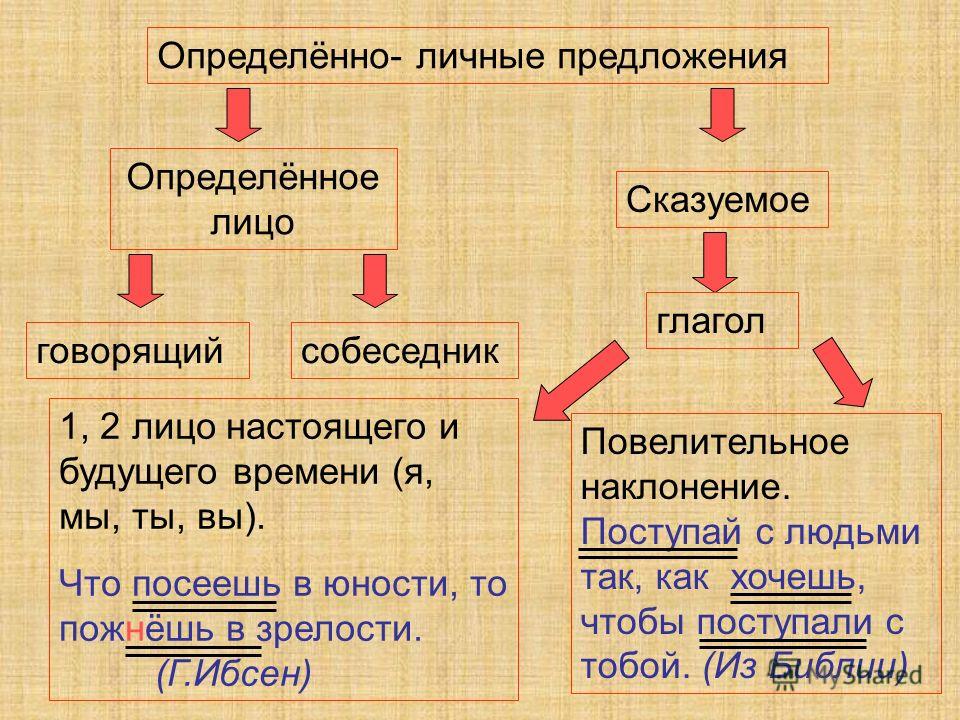
Are these sentences vaguely personal? Prove it. Then suddenly it was as if I remembered something. (L. Tolstoy) Someone came for me... (A. Pushkin) They put out the lights in the yard, and we went to bed. On holidays they wear new dresses and receive gifts.
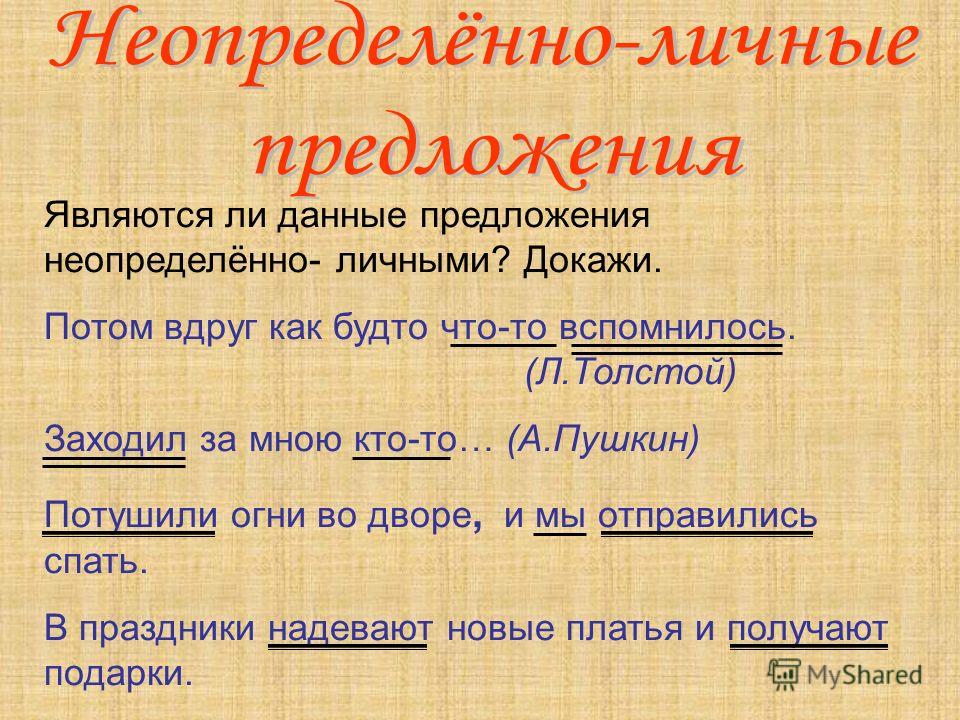
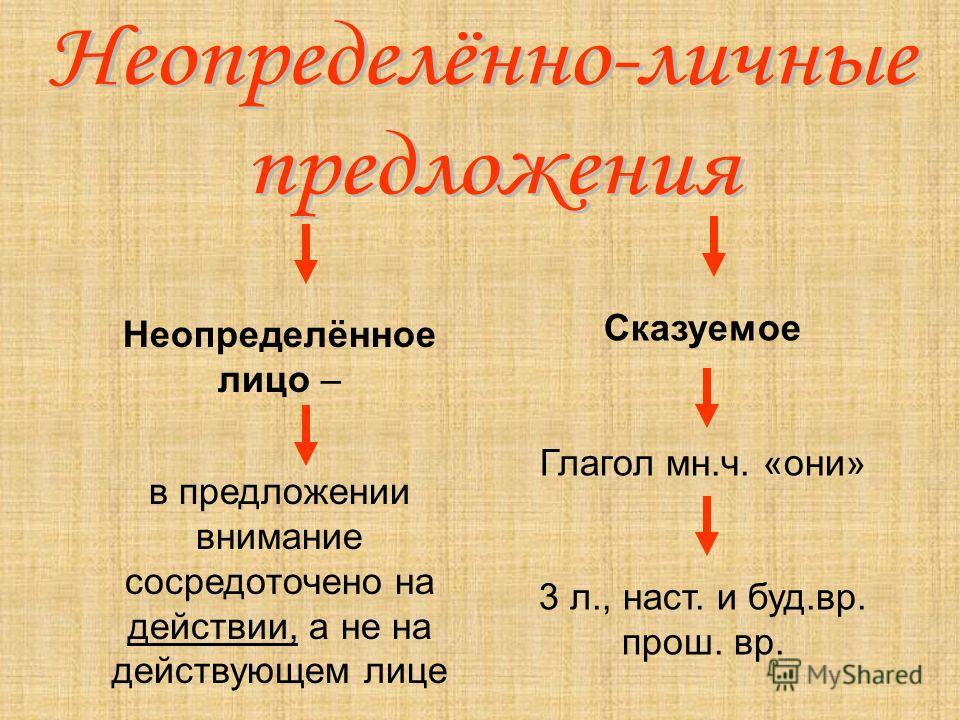
Find one-part sentences and determine their type, write down the text, inserting missing commas and letters. At one time there was a debate about what to call the horizon. I somehow didn’t like this Greek word despite the... authority of M.V. Lomonosov who knew it. The word “okoem” (look around with the eye) was proposed, but it was not approved, just like the “ovid”, “ovidki”, “mischief” proposed by V.I. Dalem. At the end of the eighteenth century, the word “circle...zor” appeared in the meaning of “horizon”, but this word also has a figurative meaning (the breadth of a person’s interests and knowledge). For a long time“horizon” refers to book words but now such restrictions have been lifted. and and and i o o a a a a a a a e i en, n/l
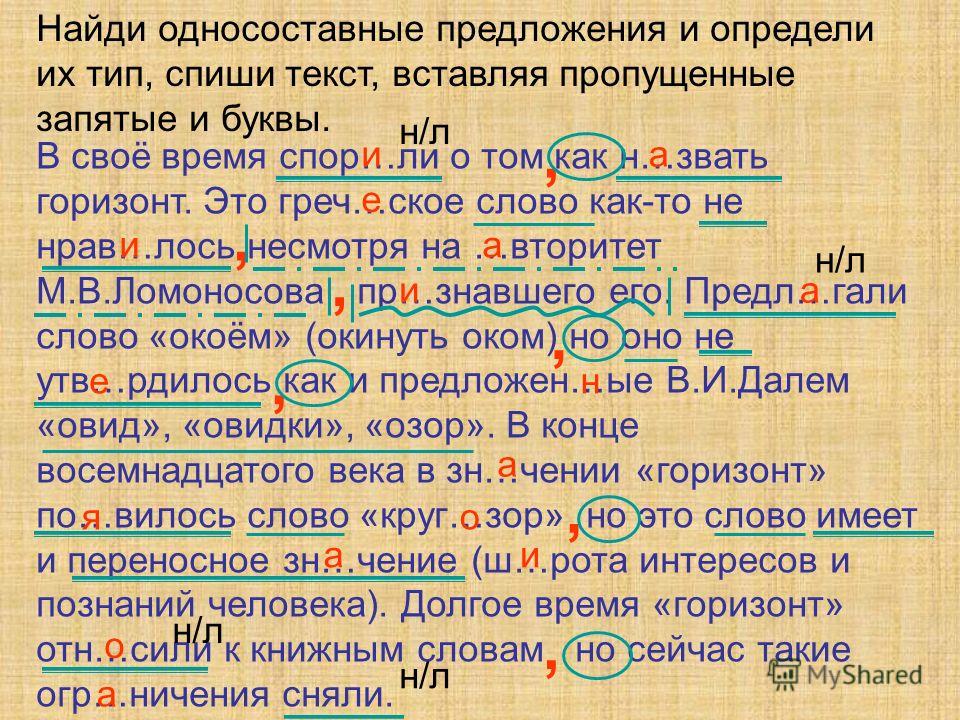
The meaning of these sentences is the state of something, someone. They do not and cannot have a subject, but the action occurs by itself or by the will of some powerful forces. Snow covered the roads. Snow covered the roads. Coolness blows from the lake. It’s cool by the lake. I breathed fresh air easily. It was easy to breathe on fresh air. Two-part One-part, impersonal
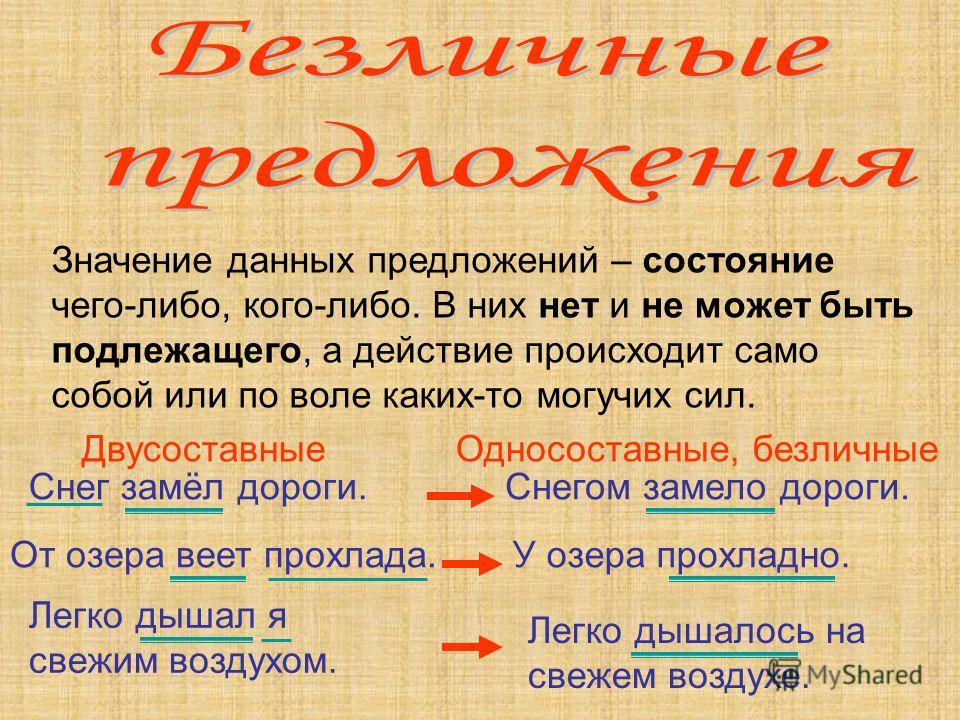
Find impersonal offers, underline the predicates. What do you know about compound predicates? And it’s boring and sad... but there’s no one to give a hand in a moment of mental anxiety (M.Yu. Lermontov). The trees are so dark and strangely silent and the heart is so sad... but the heart is not happy either. (K.D. Balmont)., b/l e a dd t t,

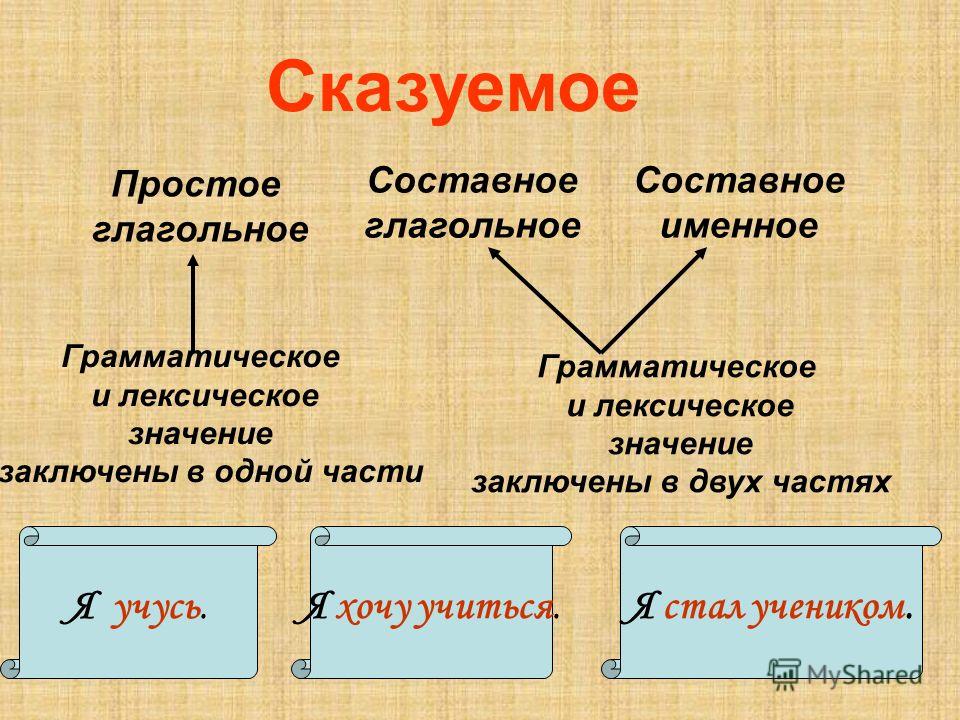
The presence of objects or phenomena is asserted. - Brevity and conciseness of statements. - They name objects, places or times of subsequent events, that is, they introduce the reader into the setting of the action. 1) Winter. The peasant, triumphant, renews the path on wood... (A.S. Pushkin) 2) Forest. Tent. The splash of a river wave. (A. Yashin) The main member of a sentence is the subject expressed by a noun.
![]()
Identify the type of sentence by highlighting the grammatical basis. 1) One-piece – two-piece; 2) One-part: definite-personal (O/L), indefinite-personal (N/L), impersonal (B/L), nominative (N.) Autumn. Our entire poor garden is crumbling. Moscow! How much has merged in this sound for the Russian heart! Do you remember the grove above the river? What kind of sand? What about water? (A.P. Chekhov) O/L B/L N N N N Two-part
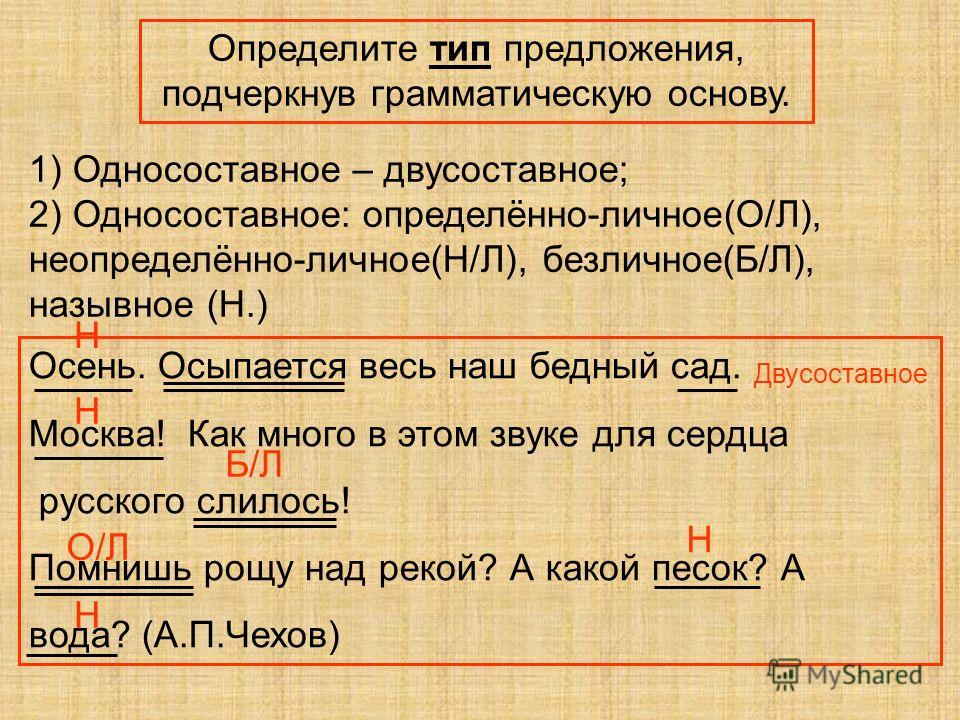
COMBINATION AND SENTENCE
LESSON #6
Subject. The proposal and its main features
Goal: to deepen and generalize students’ knowledge about the sentence as a syntactic unit; develop the skills to recognize by ear the type of sentence based on the purpose of the statement and emotional coloring; cultivate a culture of speech.
Equipment: textbook, tables, handouts and teaching materials.
DURING THE CLASSES
Even in his most beautiful dreams, a person cannot imagine anything more beautiful than nature.
A. Lamartine
II. MOTIVATION OF STUDENTS' LEARNING ACTIVITIES
III. UPDATED BACKGROUND KNOWLEDGE OF STUDENTS
(Students perform parsing phrases at the board.)
Write down the words from dictation. Make up three word combinations with them using different types subordinating connection.
Dialogue, scale, youth, peer, ladder, feel, meet, thank, surface, independence, assistant, teacher, education, only, artificial, positive, left, right, first, in Russian, completely, hotly, often.
1) What is a phrase?
2) What ways of connecting words in a phrase exist?
3) What is a proposal?
IV. LEARNING NEW MATERIAL
Exercise:
1) Read and compare the notes on the board. What is the difference?
2) Can entry No. 1 be called text? Why?
3) Can entry No. 2 be called text? Why?
4) How does a phrase differ from a sentence?
5) Name the types of sentences that are used in this text.
6) What sentences are called narrative, interrogative, incentive; exclamatory, non-exclamatory?
Using words from the dictation, compose three sentences (declarative, interrogative, motivating; exclamatory, non-exclamatory), highlight the grammatical basis in each of the sentences.
(The teacher can ask students to read theoretical material textbook.)
The sentence is the basic syntactic unit. Unlike a phrase, a sentence has a grammatical basis consisting of main members or one of them.
Sentences are characterized by intonation and semantic completeness, that is, they represent separate statements.
Sentence as a basic syntactic unit
Table No. 1
1. Purpose of the offer |
1) formation of thoughts; 2) expression of thought; End intonation is a means of expressing the semantic completeness of a statement |
2. Sentence structure |
1) grammatical basis; 2) grammatical connection components; 3) order of components; 4) sentence structure diagram |
3. Grammatical meaning offers |
1) type of sentence according to the purpose of the statement; 2) correlation of the meaning of the statement with reality; 3) semantic relations between sentence components |
Table No. 2
Types |
Rank |
Examples |
According to the purpose of the statement |
Narrative |
The West fades into the pale pink distance. |
Interrogative |
where is my friend? |
|
Incentive |
You should check the translation! |
|
Exclamation marks |
Be silent! Terrible century! |
|
By the number of grammatical bases |
Simple (one grammatical stem) |
The road went along the steep bank of the Dnieper. |
Complex (several grammatical basics) |
The river had not yet frozen, and its leaden waves sadly blackened in the monotonous banks. |
|
According to the structure of the grammatical basis |
Two-part (subject + predicate) |
The grass dries quickly. |
Mono-member (with one main member) |
It will be dawn soon. |
|
By the presence of minor members of the sentence |
Common (there are minor members) |
It will be dawn soon. |
Unexpanded (no minor members) |
Dawn begins. |
V. CONSTRUCTION OF LEARNED MATERIAL
(Work is done at the board.)
Student assignment
1) Write down the sentences as dictated by the teacher.
2) Highlight the grammatical bases in the sentences.
3) Give a description of the proposals, guided by table No. 2.
1. I remember the early fine autumn. 2. There is a wonderful smell of apples everywhere. 3. In the thinned garden, the road to the hut is visible far away. 4. The wind does not move. Silence. 5. Late night. The sea is noisy outside the window. 6. One day I was walking along the road from the city. It was getting dark.
(Performed by several students.)
Student assignment
1) Rewrite the text, inserting missing letters, opening parentheses and adding punctuation.
2) Highlight the grammatical basics.
3) Give a description of the proposals in accordance with table No. 2.
Card
The other day I spent the night on a steppe lake || It is almost entirely... high... reeds... m || In the middle of the b..stele there is a..stripe clean water|| Slowly went out in vain || The first stars were reflected in the calm water || The night would quickly pass || Before dawn, an alarming duck cry made me wake up || (What) were the ducks worried about || Who could have disturbed them || Some kind of shadow flashed before my eyes; whose wings barely touched my face || Owl || That's who kills birds at night || Beware of the night(?) predator(?) ||
(According to N. Nikonov)
(Performed by several students high level.)
Write a miniature essay (description) on the topic “My favorite place on planet Earth,” using simple narrative, interrogative, incentive, exclamatory, non-exclamatory, one-part, two-part, common, non-common sentences.
(During individual work The teacher invites the rest of the students to do the exercises from the textbook.)
VI. SUMMARY OF THE LESSON
1) What is a proposal?
2) How does a sentence differ from a phrase?
3) What are the main features of the proposal?
4) What is the grammatical basis of a sentence?
5) Name the types of sentences according to the purpose of the statement.
6) How are sentences divided according to the number of grammatical stems?
7) How do sentences differ in the number of main members in the grammatical basis?
8) How do proposals differ based on the presence or absence of secondary members?
Conclusion. Unlike phrases, sentences have a grammatical basis consisting of main members (two-parts) or one of them (one-parts). Sentences are characterized by intonation and semantic completeness, that is, they represent separate statements (narrative, interrogative, incentive). Based on the number of grammatical stems, sentences are divided into simple and complex, and based on the presence of minor members - into common and non-common.
VII. HOMEWORK
1. Learn theoretical material.
2. Complete exercises from the textbook (teacher’s choice).
3. For high-level students, complete a miniature essay, highlighting the grammatical basis in the sentences.
“Internal structure of the Earth” - The equatorial radius of the planet is R = 6,378 km. average speed orbital movement – 29.8 km/s. Structure of the Earth. Scheme heat balance Earth. The mass of the Earth is M = 5.974?1024 kg, average density 5.515 g/cm3. Radiation belts. Internal structure giant planets. Composition of the Earth by chemical elements.
“Flower structure” - Perianth. Receptacle. Types of plants. Lesson summary. Label all parts of the flower. Flowers. Homework. Lesson topic: “Structure of a flower.” Lesson topic: “Flower”. Check of knowledge. Goal: to consolidate knowledge about the structure of a flower as a plant reproductive organ. Pestle. Stigma. Plants that bear both pistillate and staminate flowers are called monoecious.
“Skin structure” - Vitamin D production. Melanin production, protection from UV rays. Skin diseases. What does the urinary system consist of? Protection against bacteria. Exhale. Protection from mechanical damage. Hygienic requirements to clothes. Abstract "Skin diseases". The skin speaks emotional state person.
“Structure of the lungs” - Diagram of the structure of the respiratory organs. Name the main differences between living organisms and inanimate bodies. Play sports; Strengthen yourself. Eat more vegetables and fruits. The structure of the trachea and bronchi. Warming the air Purifying the air Humidifying the air. What can’t a person live without for more than 5 minutes? Sound production Protection respiratory system from food ingress.
“The atom and its structure” - Answers. Answers: As a result of a-decay, the nuclear charge decreases by 2 and the mass number by 4 units. Educational: repeat, summarize and systematize theoretical knowledge on topics: "Structure of atoms. It should follow that atoms are not stable formations. How many protons and neutrons are contained in the nucleus of an oxygen atom?
“Structure of matter, grade 7” - Each stage of the work ended with a summary of the results. Lesson Objectives: Light the alcohol bottle. What can you say about the size of the molecule? Why does the volume of a body increase when heated, and decrease when cooled? Wear and tear of shoes, depressions in the steps of ancient stairs, wiping the elbows of jackets... Form an idea of the structure of matter based on independent experimental work students.
MCs lack a nominative function, are not members of a sentence, and are not grammatically related to the words in a sentence. Syntactically they are used:
1) in the role of a word-sentence, more often in dialogical speech. -Will you buy this book? - Undoubtedly.
2) as an introductory word with a modal meaning. Of course, you don't care about me.
By origin they are associated with different parts of speech.
MS express
1) lexical assessment statements, the reality of what is being communicated: indeed, of course, of course
2) possibility, probability of what is being reported, assumption, doubt about its reliability: perhaps, apparently, perhaps
MS is sometimes referred to as:
1) introductory words expressing an emotional attitude to the facts of reality: unfortunately, fortunately
2) words with the meaning of explanation, limitation: in particular, by the way, however
3) words indicating the connection of thoughts, the order of their presentation, the method of presentation: firstly, finally, on the contrary, however.
44. Subject of syntax. The connection between syntax and vocabulary, morphology and phonetics. Basic units of syntax. Syntactic relations and means of their expression.
Syntax is central to grammatical system language. Words functioning in a message are nominative units, and on the other hand, morphological units are the form of words. They belong to the word, but at the same time function in a syntactic structure (in a sentence). Word combinations are built from words, and then simple sentences... as part of a sentence, word forms act as members of a sentence. From simple sentences are being built complex sentences, and complex syntactic wholes are created from various types of complex and simple ones.
The question of the number and composition of syntactic units is debatable. All scientists recognize only phrases and sentences as syntactic units. A sentence is the minimum unit of coherent speech, which constitutes the main object of study in syntax. A collocation is a grammatical combination of two or more significant words and is used to express relationships between objects. The falling snow stopped and hung in the air to listen to the ringing stream flowing from the house. And Cinderella looked smiling at the floor. Crystal slippers stood near her bare feet.
Syntactic units, like morphological ones, can have lexical and grammatical meaning. Lexical meaning is determined by the meanings of the words that make up a phrase or sentence. Grammatical meaning is the general categorical meaning of a whole group of phrases or sentences. Bright day (l.zn. - sunny day; gr.zn. - object and its attribute). Depending on those lexical means, which are included in the sentence with the same sentence model structural types may vary. It's coming! Two-part, incomplete. Freezing. Single-part, impersonal, complete.
2. Syntactic connections and relationships between the components of syntactic units are the main feature of any syntactic constructions. Thus, in syntax, two types of connections are distinguished: coordinating, with the help of which homogeneous members of the sentence are connected (white and fluffy snow) and parts of the SSP (the transparent forest alone turns black,...). Subordinating connections connect: firstly, word forms as part of phrases (wonderful evening); secondly, parts of the SSP (there was no hope that the sky would clear). Relations in syntax are predicative and non-predicative. Predicative - the relationship of subject and predicate (snow was falling). Non-predicatives are coordinating and subordinating.
45. Collocation as a syntactic unit, its semantics and structure. Types of phrases.
A phrase is a syntactic construction formed by combining two or more significant words based on a subordinating relationship (white snow, desire to learn). Depending on the number of components, phrases are distinguished as simple, complex and combined. Simple - consist of two components (a beautiful lamp, a middle-aged man ).Complex phrases are divided into two types: complex and combined. Complex - in them several subordinate words depend on one main word, which do not enter into any relationship with each other (lie down on the sofa to rest). The peculiarity of combined ones is that they have more than one core word (read an interesting book).
Depending on the degree of fusion of components, phrases are divided into free and non-free. In a free phrase, the self-lexical meanings of all words included in the phrase are preserved. The components of such a phrase can be freely replaced by words of a similar kind (late autumn). In non-free s/s, the lexical independence of one or both components is weakened or completely lost. Such a s/s is close in meaning to a word and can be replaced with one word (knuckle down = idle). Non-free s/s are divided into two groups: non-free syntactically and non-free phraseologically. Not free syntactically are s/s lexically related and not divisible in a given context (a girl came up to me tall). Tall - serves as one member of the sentence and exists as part of this s/s lexically poor, because if you remove the adjective, then you can’t say that. In another context, it may be free s/s (the girl’s tall height made her stand out in the group). Non-free phraseological s/s are those s/s that exhibit lexical lack of independence in any context (work carelessly).
The grammatically dominant word constitutes the core, main component of the s/s, and the grammatically subordinate word constitutes the dependent component. s/s serves as a name for phenomena of reality, but unlike the word, the name is more specific and more complex. Depending on whether the main word belongs to a particular part of speech, lexico-grammatical types of s/s are distinguished:
A) verbal s/s: - s dependent noun. Can be non-prepositional (read a book) and prepositional (go to the road); - the dependent word can be an infinitive or a gerund (ask to come, sit thoughtfully); - an adverb can be dependent (it’s interesting to tell).
B) personal s/s:
* Substantive (noun): - dependent noun (president’s speech); - dependent adjective (sable cap); - dependent pronoun (my nigga); - dependent adverb (Turkish coffee); - dependent infinitive (the desire to flash).
* Nominal adjective (adjective) – dependent noun (submissive to fate); - dependent places (we need); - dependent adverb (very scary); - dependent infinitive (ready to fight).
* Nominal words with ch. numeral (fifth of the passengers).
C) adverbial s/s: - dependent other adverb (very skillfully); - dependent noun (funny to the point of tears).
5. Syntactic relations between members of the s/s are built on the basis of a subordinate relationship. Subordinating connection is always subordinate in nature. This connection is one-way. This connection in language is realized in three main ways.
1. Agreement is a subordinating relationship in which the main word requires that the dependent word be placed in the same grammatical forms, in which the main thing appears, that is, these are forms of the gender of the case number (green tree). If the words agree in this way, then this is complete agreement. Agreement is incomplete when the dependent word does not coincide with the main word in all grammatical forms (city of Moscow).
2. Control is a type of subordinating connection in which, to express semantic relations, the main word requires the delivery of a dependent word in a certain case (the verb “see” requires the delivery of nouns in VP). when controlling, the main word can appear in any inflectional forms inherent to it. The choice of dependent word is determined by the main word (see the fox). The dependent word nickname does not change when the main word changes. There are strong and weak controls. Strong management due to the fact that the main word has such properties that it requires a dependent word, that is, such a connection is necessary. Transitive verbs (send a letter) always require this connection. With weak control, the dependent word is not mandatory for the main one. The main word can be used in a sentence without a dependent (water the flowers - water from a watering can).
Adjunction is a subordinating relationship in which the main word does not require certain grammatical forms from the dependent word, because the dependent word is unchangeable (quick to write). The main word in adjacency is that, which can take different forms. If the main word, like the dependent word, is unchangeable, then the main word is the one that can be used in a sentence without a dependent one (I went very quickly). Dependent word when adjoining there can be an adverb, an adjective or an adverb in the comparative degree (to rush faster than a train), a gerund (to talk without stopping), an infinitive (wanted to study), an unchangeable adjective (the color beige).
46. Sentence as a communicative unit, its semantics and structure. Current division of proposals.
The theoretical basis of syntax is the sentence. A sentence is the primary communicative unit of human speech, which is a grammatically organized combination of words, or a separate word that has a certain semantic and intonation design. Being a unit of communication, a sentence is also a unit of formation and expression of thought. A sentence is correlated with a logical judgment, but is not identical to it. Every judgment is expressed in the form of a sentence, but not every sentence is a judgment. Representatives of different directions define the essence of a proposal in different ways. The logical direction (Buslaev) defines a sentence as a judgment expressed in words. The psychological direction (Potebnya) defines a sentence with a predicate, equates it to a verb, therefore a sentence exists only where there is a verb. Formal-grammatical orientation (Fortunatov) considers a sentence as one of the types of s/s. Academician Vinovo made a very great contribution to the development of supply theory. A sentence is an integral unit of speech, grammatically formed according to the laws of a given language, which is the main means of forming, expressing and communicating thoughts.
Every sentence contains a message about some phenomenon of reality. The main leading feature of a sentence is predicativity - the expression by linguistic means of the relationship between the content of what is being expressed and reality. The grammatical means of predication are: category of tense, category of person, category of modality. Predicativity is a complex grammatical category; its essence is that each sentence is correlated with reality and is evaluated by the speaker. The means of expressing modality are: the category of mood, special lexical and grammatical means (modal verbs, modal words, modal particles). There are two types of modality: Objective (the meaning of reality or unreality. This meaning is inherent in every sentence. The night is quiet; the night would be quiet), subjective (the attitude of the speaker to what he says. Expression of mode in words and particles. He will probably come; he is unlikely to come ). The sentence highlights its predicative basis. In two hundred sentences this combines the subject with the tale. And in most cases, the one-part sentence is a verb form. An essential feature of a sentence is intonation (question, motivation, message). Intonation performs the following functions: - gives completeness to the sentence; - expresses the emotional side of speech and can influence the listener; expresses volitional impulses; can express modal shades of a sentence. The structural diagram of a sentence is an abstract pattern according to which any sentence is built. Student (N1) xthnbn(Vf), draw a diagram. Spring. It's getting light. Paradigm - various shapes words, sentence, s/s. Each proposal has its own paradigm. It is usually seven-membered: present time, past time, future time - expressive, may be unreal - reference cash, desired meaning, meaning of obligation, expression of motivation.
Depending on the characteristic included in the classification, the proposals differ:
1) simple (consisting of one predicative unit) and complex (consisting of two or more predicative units)
2) affirmative and negative - according to the nature of the attitude to reality expressed in them.
3) narrative, interrogative and incentive - according to the purpose of the statement
4) one-part and two-part - depending on the presence of one or two main members as organizing members of the proposal
5) widespread and not widespread - according to the presence or absence of minor members
6) complete and incomplete - by the presence or partial absence of all necessary members of a given sentence structure
7) syntactically divisible and indivisible - in the presence or absence of the possibility of dividing a sentence, that is, identifying individual members in its composition.
Along with the formal grammatical division of a sentence, the identification of main and secondary members in it, there is a semantic division, the so-called actual division. Its essence is as follows: in the first place is put what is known from the previous context or situation (given), in the second place is another component of the sentence, that for the sake of which it is created (new). This fully corresponds to the pattern of thought moving from the known to the unknown. The first part is called the basis of the statement (rheme), the second - the core of the statement (rheme).
Not all sentences have a theme and rheme; there are so-called undivided sentences. It was raining.
47. The structure of a simple sentence. Question about structural diagram offers. The concept of members of a sentence, main and secondary members of a sentence. Indivisible sentences.
The type of sentence in structure (structure) is determined by the grammatical basis. It may consist of two main members (subject and predicate) or one main member.
According to the structure of the grammatical basis, simple sentences are divided into one-part and two-part. Sentences whose grammatical basis consists of a subject and a predicate are called two-part. Sentences whose grammatical basis consists of one main member are called one-part sentences.
Based on the presence of minor members, sentences can be uncommon or widespread.
The main parts of a sentence are the subject and the predicate. The subject determines the structure of the sentence, since it names the subject of speech, the predicate is subordinate to the subject in meaning and grammatically. However, the predicate more often than the subject expresses the semantic center of the statement.
The subject with the words dependent on it forms the composition of the subject, and the predicate with the words dependent on it forms the composition of the predicate.
Secondary members of a sentence are those that are in a subordinate relationship with the main members of the sentence or with each other and serve to clarify, clarify, and supplement the meanings of the dominant words.
The question of minor members of a sentence has been and is being resolved differently in Russian grammar. Some scientists denied the legitimacy of including the theory of minor members in the field of grammar, noting the predominance in this theory of logical-semantic concepts over grammatical ones and pointing out that in order to clarify the relationships between the members of a sentence, one can limit oneself to establishing the nature of the syntactic connection between words in a sentence. Other scientists included the theory of HF in Russian grammar, but their cassification was based on on different grounds. Minor members were distinguished either by meaning or by type syntactic connection with other words. This is how two directions in the doctrine of HF were formed: logical (in meaning) and formal-grammatical. In the practice of modern teaching, the use of a logical classification of HF, built taking into account both grammatical and lexical meanings subordinate and subordinating words and syntactic connections between them.
The following categories of HF are distinguished: 1) definition, a variation of which is insertion, 2) definition, 3) circumstances. This classification, which is generally suitable for syntactic parsing by sentence members, in some cases may turn out to be too schematic, since it does not take into account the possibilities transitional phenomena in the field of high frequency and combination of meanings of different syntactic categories.
Sentences expressed in one word or a stable phrase that do not distinguish individual members in their composition and perform a communicative function most often in dialogic speech are called indivisible. They are otherwise called sentence words. The presence of this synonymous definition has its own convenience: it allows you not to confuse indivisible sentences with indivisible ones.
The following categories of indivisible sentences are distinguished:
1) affirmative words-sentences. Yes. Certainly. Exactly.
2) negative. No. Nothing. Not at all.
3) interrogative. How so? Really?
4) incentive. Well, that's it! Come on, come on!
5) emotional-evaluative. Fathers! (the last two groups are interjection sentences)
48. Subject, its semantics and methods of expression in modern Russian.
A distinction is made between sentence members that are morphologized, that is, expressed by that part of speech for which a given syntactic function is the main one. The wind is getting stronger – morphologized members.
Non-morphologized members of a sentence are expressed by parts of speech for which this function is not the main one. Strong wind.
A day in April is remembered for a long time - here is a non-morphologized definition.
The subject is the main member of a two-part sentence, grammatically independent of other members and denoting the subject of thought (in broadly understood), the predicative features of which are determined by the predicate.
Nature has placed in man the need to care for all people.
The most best feature the prophet is a good memory.
The subject denotes the producer of the action or the bearer of the attribute, therefore it can name living beings, persons, inanimate objects, phenomena, concepts.
The grammatical meaning of the subject (semantics) is the meaning of objectivity. From the definition of the subject as an independent member of a sentence, it follows that the morphologized form of its expression is a noun in the idiom and personal pronouns. Inspiration comes during work. The generalized objective pronoun who or what is also a morphologized form. Who jumps, who rushes under the cold...
All other ways of expressing the subject are non-morphologized members of the sentence, i.e. forms of the subject.
The demonstrative pronoun in the role of the subject should be distinguished from those cases when the pronoun acts as a particle.
This would happen sooner or later.
It is excellent.
World history is a world court.
The subject can be expressed by an infinitive. Such a subject is placed before the predicate, in pronunciation it is separated from it by a pause, in writing - by a dash.
Joking with a dream is dangerous.
Such sentences must be distinguished from one-part sentences, in which the infinitive is dependent and usually refers to words of the state category and appears in postposition.
It was difficult to make sense of the ruins and debris.
Humans tend to make mistakes.
But. It is difficult to dissuade him of anything; it is impossible to argue with him.
The subject can also be expressed by a quantitative nominal combination.
Two friends were walking in the evening.
I am sixteen years old.
The can contains seven liters of gasoline.
How few of us survived the battle.
The subject can be expressed by a combination of two nouns in I. p. and Tv. n. with the value of compatibility.
How did it happen that the crucian carp and the ruff got along?
If the predicate is expressed in singular form. h., then only the form I. p. should be considered subject.
A mother and child were crossing the street.
The Countess and the girl went to finish the toilet.
49. Types and forms of the predicate.
The predicate is the main member of a two-part sentence, denoting a predicative feature (action, state, quality) of the subject that is the subject.
Glory flees from those who obtain it through low means.
The child loves candy.
From the definition it follows that the predicate must be asked a question that is universal in every case: what is said about the subject? - This is not a logical question, but a grammatical one.
The grammatical semantics of the predicate is the expression of an active or passive attribute belonging to the subject - its predicative attribute.
The law is powerful, but the power of need is stronger.
The morphologized form of expression is the finite verb, or the conjugated form of the verb (inflected). The syntactic meaning of the predicate consists of two parts: material (semantics, predicative attribute of the subject) and formal (mood, tense, person).
Apple trees are blooming.
The apple trees continue to bloom.
Apple trees in bloom.
In 1 and 2, the real and formal parts interact. There is a real plan here (present tense, plural). In sentence 3 there is no connective and this is also significant - the absence of a connective indicates the present tense.
Currently, there are 2 trends in the development of predicate forms: the expansion of the use of tense forms and the growth of analyticity - the following sentences are increasing in use: Everyone moved. and everyone was on the move. The last analytical one. This is due to the increase in expressiveness of expression.
On an empty face even a scratch is a decoration.
In SRL, the position of the predicate can often be replaced by an entire sentence.
The pie is to die for.
The wind - you can’t stand still.
Predicate types:
From the relationship between real and formal meaning in the SRL, the following are distinguished:
I. Verb predicate
II. Nominal predicate.
I. In a verbal predicate, the real meaning is expressed by the verb, and in a nominal predicate - by the name. Has three varieties:
1. Simple verb
2. Compound verb.
3. Complex (complicated) verb.
1. Simple verbal predicate is a predicate in which the real and grammatical meanings are expressed in one word form. A simple verbal predicate can be expressed by verbs of all three tenses of the indicative mood.
People die so that humanity can live.
We won't be sad.
In the imperative mood.
May you have the best dreams.
Subjunctive mood.
If only spring would come.
A simple verbal predicate can also be expressed in the infinitive form.
I go for the book and run.
A simple verbal predicate can be expressed in phraseological units.
This question struck a chord with me.
In a simple verbal predicate, the real and grammatical predicates are expressed in the 1st form.
2. Compound verbal predicate – a predicate in which the real and grammatical meanings are expressed in different words.
He tried(d) to explain(c).
He continued to laugh (c).
The grammatical meaning is expressed by a verb of incomplete lexical meaning. These verbs can indicate beginning, end, duration, desirability, etc.
My friend started studying at the institute (continues, stopped, wants to, maybe is going to).
the real meaning is expressed by the dependent subject infinitive. The subject is an infinitive that denotes the action of the same person as the action of the personal verb. The subjective infinitive should be distinguished from the objective infinitive. The objective infinitive is not part of the predicate.
My friend started studying at the institute. (all applies to 1 person) – sub.
My father told me to study at the institute. - about.
Young Dubrovsky wanted to do business.
The part of the predicate that expresses the grammatical meaning is called the auxiliary part. In addition to the verb, the auxiliary part can be a short adjective.
I'm ready to love the whole world.
He is ready to help you (should, glad).
Despite the fact that the adjective plays the role of the auxiliary part here, the predicate remains a compound verb, since the real meaning is expressed by the verb.
3. A complex verbal predicate is a predicate in which the real meaning is expressed by an infinitive, and is complicated by an auxiliary component, and in this case indicators of two particular meanings (modal and phase) appear.
Shubin wanted (mod) to start (phases) working (things).
I shouldn't (mod) dare (phase) tell (things) to you about this.
II.1.Composite nominal predicate, this is a predicate, the real value of which is expressed by a name. (noun, adjective, numeral, pronoun), and the grammatical meaning is expressed by zero or materially expressed connectives. Materially expressed ligaments:
Abstract (pure) – the verb to be, when it has no real meaning, in different forms tense and mood.
Infantry is infantry.
Grammar and arithmetic are sciences.
Semi-abstract connectives, verbs with a weakened lexical meaning, usually denoting a transition from one state to another. Most often, such connectives are the verbs become, seem, become, appear and some others.
Already in the grove the light becomes fire.
Significant connectives are verbs with the meaning of action, state, movement. These verbs can act as a predicate independently, but in these constructions they perform the function of a connective.
I was born a tumbleweed.
The young lady wanders around looking so sad.
Available in name compound predicate and the zero copula, not materially expressed, serving as an indicator of the present tense of the indicative mood.
Man is (is) the smith of his own happiness.
This girl is like a holiday.
2. a complex nominal predicate consists of a phase and modal verb+ abstract or semi-abstract connective + nominal part.
I really want to be a general.
Prince Vasily's judgment continues to be fair.
50. Types of minor members of a sentence according to their function. Semantic grammatical categories of minor members: addition, definition, circumstance.
Secondary members of a sentence are those that are not included in its grammatical basis. Among them, definitions, additions and circumstances differ.
The traditional doctrine of minor members of a sentence has always been associated with controversy surrounding the issue of the principles of classification of minor members.
The following provisions were generally accepted:
There are 3 classes: complement, definition and circumstance. Subclasses: direct and indirect objects; consistent and non-harmonized definitions and applications; different types of circumstances.
The selection criteria are used: a) morphological characteristics of the most minor member; b) morphological characteristics of the sentence member it defines; c) semantic relationships between minor member and the one on which it depends
